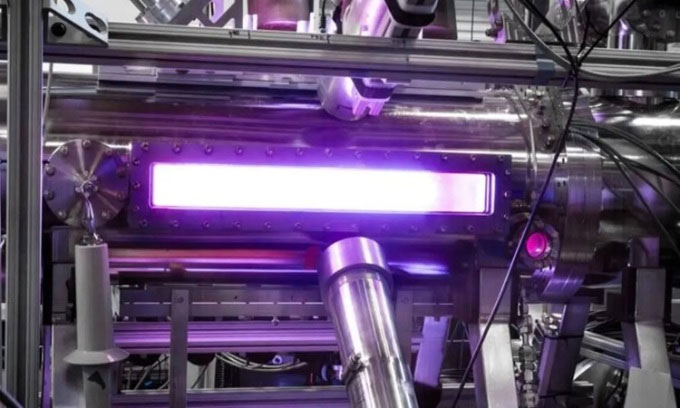Fusion power generation equipment reaches temperatures of 37 million degrees Celsius
FuZe is a small, low-cost device that can reach fusion power temperatures quickly and meet future human electricity needs.
A compact device built by fusion energy startup Zap Energy in the US reaches electron plasma temperatures of about 1 - 3 keV, equivalent to 11 - 37 million degrees Celsius, Interesting Engineering reported on April 23.

Flashes of light from the plasma of the FuZe device. (Photo: Zap Energy).
In nearly a century of human research into fusion reactions, only a few technologies have achieved plasma temperatures above 15 million degrees Celsius, the temperature at the core of the Sun. As the world searches for cleaner solutions to meet energy needs, fusion is seen as a viable way to generate large amounts of energy. The first step in the process is the production of plasma , the fourth state of matter in which electrons do not maintain an atomic state but float freely. Atomic fusion releases 10 million times more energy than coal. However, because fusion plasma consists of two components (nuclei and electrons) that differ significantly in mass, they heat up and cool down at different rates. Rapid cooling of electrons can limit the heating of the plasma, creating an obstacle in the development of fusion reactors.
The US Department of Energy's Advanced Research Projects Agency-Energy project funds research on this issue at the University of Washington. From this research, Zap Energy was founded in 2020, using a plasma confinement idea called the Fusion Z-pinch Experiment (FuZe) to ensure electrons do not cool quickly. In their method, electrons flow through thin filaments of plasma, creating an electromagnetic field that heats the plasma while compressing it. However, the problem with the above method is that the plasma only lasts for a short time. Zap Energy addresses this limitation with a process called slipstream stabilization.
Now, researchers can measure the separate temperatures of nuclei and electrons in plasma. Zap Energy partnered with researchers at Lawrence Livermore National Laboratory (LLNL) and the University of California, San Diego (UCSD) to measure the temperature of electrons from FuZe.
In the Thomson scattering method, the team fires extremely fast pulses of green light into the plasma. They measure the dispersion of electrons and their temperature. Measurement results confirm that the electrons in the FuZe plasma are as hot as the nucleus and that the plasma maintains a healthy thermal balance. Unlike other fusion technologies, FuZe does not need superconducting magnets or powerful lasers to create plasma, so it is very cost-effective.
The FuZe research was published in the journal Physical Review Letters. The research team has begun work on the next project, Fuze-Q, which has an energy capacity 10 times greater than FuZe and can reach much higher temperatures.
- Fusion reactor hits 100 million degrees Celsius
- May 27: Creating the highest temperature of 510 million degrees Celsius in the laboratory
- Need to remember sunny days: Certainly do not sit on the saddle
- The laser is capable of heating up to 15 million degrees Celsius
- The fusion reactor is 7 times hotter than the core of the Sun.
- Korea's fusion reactor is 7 times hotter than the Sun's core
- Grid fusion synthesis power in 2050
- The temperature of the oceans billions of years ago is not hotter than today
- Temperatures in the Northern provinces are down to 14 degrees Celsius
- Discovering planets hotter than 2,000 degrees Celsius
- Record hot sun in India, flying birds must also fall to the ground
- Temperatures in cities will increase by 8 degrees Celsius by the end of the century
 The US company is about to build a supersonic passenger plane of 6,000km / h
The US company is about to build a supersonic passenger plane of 6,000km / h Japan develops avatar robot as in fiction film
Japan develops avatar robot as in fiction film Australia tested the world's first mango picking robot
Australia tested the world's first mango picking robot America develops technology to separate water from animal waste
America develops technology to separate water from animal waste